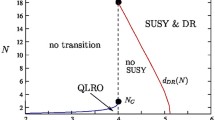Abstract
An order parameter description of the Anderson-Mott transition (AMT) is given. We first derive an order parameter field theory for the AMT, and then present a mean-field solution. It is shown that the mean-field critical exponents are exact above the upper critical dimension. Renormalization group methods are then used to show that a random-field like term is generate under renormalization. This leads to similarities between the AMT and random-field magnets, and to an upper critical dimensiond +c =6 for the AMT. Ford<6, and ε=6−d expansion is used to calculate the critical exponents. To first order in ε they are found to coincide with the exponents for the random-field Ising model. We then discuss a general scaling theory for the AMT. Some well established scaling relations such as Wegner's scaling law, are found to be modified due to random-field effects. New experiments are proposed to test for random-field aspects of the AMT.
Similar content being viewed by others
References
Mott, N.F. Metal-insulator transitions (London: Taylor & Francis 1990)
For a review, see, e.g., Belitz, D., T.R. Kirkpatrick; Rev. Mod. Phys.66, 261 (1984)]
Finkel'stein, A.M.: Zh. Eksp. Teor. Fiz.84, 168 (1983) [Sov. Phys. JETP57, 97 (1983)]
Eegner F.: Z. Phys. B35, 207 (1979)
Finkel'stein, A.M.: Zh. Eksp. Teor. Fiz86, 367 (1984) [Sov. Phys. JETP59, 212 (1984)]
Castellani, C., C. DiCastro, P.A. Lee, M. Ma: Phys. Rev. B30, 572 (1984)
For a recent review, see, D. Vollhardt: in: Correlated electron systems. V. Emery (ed.) Singapore World Scientific 1993
See, e.g., S.-K. Ma, Modern theory of critical phenomena. Reading, Mass: Behjamin 1976; M.E. Fisher, in: Advanced course on critical phenomena, p. 1. F.W. Hahne, Heidelberg New York: Berlin Springer, 1983
Harris, A.B., Lubensky, T.C.: Phys. Rev. B23, 2640 (1981); see also Marston, J.B., Affleck, I.: Nucl. Phys.B 290 [FS20], 137 (1987)
That this really is the most obvious simple OP can be seen from [9] and from the further development in Sect. II, III
Wegner, F.: Z. Phys. B44, 9 (1981). Wegner proved that the DOS is neither zero not infinity anywhere in the band for a large class of models for noninteracting electrons. This ruled out the theory of [9], and precludes using the DOS as on OP, although nonanalyticities of the DOS within the band are still possible
Fyodorov, Y.V., Mirlin, A.D.: Phys. Rev. Lett.67, 2049 (1991)
Kirkpatrick, T.R., Belitz, D.: Phys. Rev. Lett.73, 862 (1994)
kirkpatrick, T.R., Belitz, D.: Phys. Rev. Lett.74, 1178 (1994)
Imry, Y., Ma, S.K.: Phys. Rev. Lett.35, 1399 (1975); for a review see, e.g., Nattermann, T., Villain, J.: Phase transitions11, 5 (1988)
Grinstein, G.: Phys. Rev. Lett.37, 944 (1976)
Wegner, F.: Z. Phys. B25, 327 (1976)
See, e.g.,: J. Zinn-Justin,: Quantum field theory and critical phenomena, Oxford: Clarendon Press 1989
In our actual RG calculations in Sect. IV we ignore the constrainttr Q=0,(2.3b). Our rationale is that keeping additional fluctuations cannot possibly do any harm, and ignoring this constraint is technically easier than enforcing it
This statement holds perturbatively in an ε-expansion aboutd *c =6. As in the corresponding magnetic RF problems, one expects nonperturbative effects to play a major role which is not understood
Alshuler, B.L., Aronov, A.G.: Solid State Commun.30, 115 (1979)
Wilson, K.J., Kogut, J.: Phys. Rep.12, 75 (1974)
Pytte, E. Imry, Y., Mukamel, D.: Phys. Rev. Lett.46, 1173 (1981)
Aharony, A.: Phys. Rev. B18, 3328 (1978)
A more careful statement would be that there isat least one DIV. To first order in ε=6−d there is only one DIV, as the one-loop RG analysis presented in Sect. III shows. However, work on magnetic RF problems suggests that this may change neard=4, see [27] See, e.g.,. We expect the same conclusion to apply to the AMT
For a review, see, P.A. Lee, T.V. Ramakrishnan,: Rev. Mod. Phys.57, 287 (1985)
See, e.g., Fisher, D.S.: Phys. Rev. B31, 7233 (1985)
Kirkpatrick, T.R., Belitz, D.: Phys. Rev. B41, 11082 (1990)
Castellani, C., DiCastro, C., Lee, P.A., Ma, M., Sorella, S., Tabet, E.: Phys. Rev. B33, 6169 (1986)
Bhatt, R.N., Fisher, D.S.: Phys. Rev. Lett.68, 3072 (1992)
Questions concerning the scaling of σ and the background contribution to ϖn/ϖμ could be answered by a direct calculation of σ as a correlation function. Naively, a source term for σ will beQ 2, since σ is related to a two-particle Green function. The mean-field scaling ofQ then suggests [σ]=d−2. Taking into account the DIV, this is consistent with (3.16b) and (5.7d). More work is need to confirm or refute this conjecture.
Aharony, A., Imry, Y., Ma, S.K.: Phys. Rev. Lett.37, 1364 (1976), Parisi, G., Sourlas, N.: Phys. Rev. Lett.43, 744 (1979)
Fisher, D.S.,: Phys. Rev. Lett.56, 416 (1986); J. Villain,: J. Phys. (Paris)46, 1843 (1985)
Kirkpatrick, T.R., Belitz, D.: Phys. Rev. B50, 8272 (1994)
Chayes, J., Chayes, L, Fisher, D.S., Spencer, T.: Phys. Rev. Lett.57, 2999 (1986)
Castellani, C., Kotliar, G., Lee, P.A.: Phys. Rev. Lett.59, 323 (1987), Kirkpatrick, T. R., Belitz, D.: Phys. Rev. B40, 5227 (1989)
Altshuler, B.L., Kravtsov, V.D., Lerner, I.V.: Mesoscopic phenomena in solids. Altshuler, B.L., Lee, P.A., Webb R.A. (eds.) Amsterdam: North Holland 1991
Brézin, E., Wallace, D.J.,: Phys. Rev. B7, 1967 (1973)



